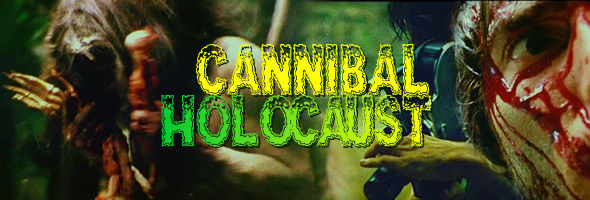
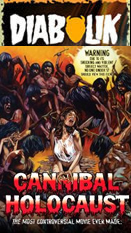

Radically ahead of its time and still unbearable to watch for many viewers, Cannibal Holocaust marks the apex (or nadir, depending on your viewpoint) of the Italian cannibal movie subgenre which flourished through the '70s and early '80s. While most cannibal films can be dismissed thanks to their kitschy special effects and laughable dialogue, this film is a far more challenging and dangerous animal than, say, Cannibal Ferox, which sticks firmly to its pulp origins and aspires to little beyond drive-in amusement. Deodato's grim world view and unremitting nastiness make for a very rough ride whose viciousness remains potent and startling. The film begins cleverly with an innocuous opening act filled with the usual endearing traits of Italian exploitation cinema: erratic dubbing, uneven pacing, and minimal location shooting in the Big Apple to pass this off as an elaborate international production. However, the main footage of the lost crew is a whole different story - raw, handheld 16mm images shot from two cameras by a quartet of filmmakers as they cluelessly tromp through the jungle, committing sexual and violent acts against the "little mud people" and even offing an animal or two in the process. The actual onscreen killing of animals is completely indefensible, of course, though unlike its utterly gratuitous presence in other films of its ilk, the verisimilitude of these sequences causes the viewer to then question the reality of everything else onscreen. The special effects, particularly the notorious image of a woman vertically impaled on a sharp pole, are so gritty and realistically handled that many viewers have taken the found footage as reality. Deodato intentionally blurs the line between cinema and actual mondo documentary filmmaking with great skill, brutally tearing viewers' preconceptions about Mondo Cane-style practices to shreds. You want to see brutality? Here it is, folks, in its ugly, all too human glory, and rarely will you see a subgenre simultaneously celebrating and devouring itself at the same time with such ferocity. Indeed, viewers who think they've seen it all will find this to be the closest thing to a genuine emotional "holocaust" ever captured in a fictional film. Love it or hate it, this is an important, vital work in both the horror and mondo genres; no other film has more horrifically captured the feeling of being Though prosecuted in its native country on the grounds of obscenity, Cannibal Holocaust appeared on video briefly in the UK before being banned as a video nasty and was never legally released in America at all apart from a fleeting grindhouse stint in larger cities. Most horror fans first came into contact with this through shoddy Venezuelan bootleg tapes, then through the Japanese laserdisc which distractingly fogged out all of the frontal nudity (a large chunk of the running time in this case). Holland's EC Entertainment presented the first legitimate, uncensored version on DVD and laserdisc, letterboxed to replicate the film’s 1.85:1 exhibition; the framing sequences were shot hard-matted at that aspect ratio, while the found 16mm footage was filmed full frame and matted off on all prints. The theatrical trailer on EC’s version includes a few glimpses of the unmatted footage, though the framing variations probably don't make much difference given the film's haphazard visual composition. Ortolani's score is isolated on the analog tracks (probably lifted from the Lucertola Media CD), and Deodato appears for a brief interview. A few stills from the notorious "piranha bait" scene, reportedly never completed, appear as a supplement; it's hard to imagine why this scene has been considered so controversial over the years, since it doesn't look even remotely close in shock value to the other cannibal segments in the film. A subsequent anamorphic reissue from EC fared better but lost a few seconds from the “Road to Hell” sequence, as this footage doesn't exist in the negative and remains absent to this day. For the more easily offended, the first UK disc from Vipco features a censored and essentially worthless print excising most of the more extreme imagery. An anamorphic Italian DVD contains a one-hour documentary as well as a fine print of the film itself and the trailer, a presentation carried over to the comparable French DVD. However, all of these options paled in comparison to the mammoth two-disc set from Grindhouse released in 2005, a five-year labor of love that finally answers many nagging questions about this very troublesome film. The film itself is presented in an anamorphic transfer with a stereo remix or the original mono (similar to their earlier job on Cannibal Ferox), with the film itself playable both in its full-strength version and an “animal cruelty free” cut when you’re not in the mood to watch turtle butchery. The DVD transfer looks excellent, though The second disc contains the full one-hour documentary from the Italian DVD, with optional English subtitles. Deodato, the great Ortolani, actor Barbareschi, and cinematographer Sergio d’Offizi are on hand to talk about their experiences on the film, interspersed with behind-the-scenes footage and tons of rare photos and ad art. Kerman pops up again in “Robert Kerman Exposed,” a half-hour chat dating from the same 2000 session used for his commentary; he’s candid about the film as well as his prolific porn career at the same time under the name Richard Bolla (including his big claim to fame, the one guy who actually does the title character in Debbie Does Dallas). Ortolani also returns for a 5-minute bonus interview about the film. However, the real gem here is “Alan Yates Uncovered,” a 51-minute interview with Yorke (who continued acting in mainstream American films under the name Carl Gabriel Yorke). He’s frank and funny about his work in the film, from the unlikely circumstances of his hiring to his arrival on the Amazon (heralded by a prosthetic leg floating on the way in the river). His accounts of both the harrowing rape scene and his uncomfortable sex scene with his female co-star are amazing anecdotes, and every minute of this piece is time very well spent. Other extras on the second disc include a massive still gallery containing behind-the-scenes shots, promotional photographs, and tons of artwork, a Necrophagia music video directed by Jim Van Bebber, and a trailer reel for other Grindhouse titles including The Beyond, The Tough Ones, Scum of the Earth, Gone with the Pope, and A Cat in the Brain. Easter egg hunters will also find loads of extra goodies here (eight of ’em!) including extra bonus trailers (such as Mr. Kerman’s most popular title), an entire hidden featurette, and other tasty treats. Not surprisingly, this quickly became one of Grindhouse's most requested titles on Blu-ray, but it didn't appear until a lavish two-disc set in 2014. In the interim fans had to deal with a truly ghastly French Blu-ray, which suffered from perhaps the worst case on record of that dreaded chunky watercolor syndrome found on many disastrous Italian-sourced HD transfers like The 10th Victim. At least it added a worthwhile new featurette about the film's rocky European distribution history, though it's in French only. Meanwhile the UK got a version from Shameless; incredibly, this one managed to escape with a mere 14 seconds of trims, mainly to the repugnant muskrat scene. There's also an alternate version supervised by However, it's the Grindhouse Blu-ray that will really make fans' heads spin as it not only ports over virtually everything (apart from the DVD-Rom script, Italian doc and selected video commentary option) while also adding a wealth of new material as well. In a structure similar to the DVD, the first Blu-ray contains the main feature with DTS-HD stereo and mono English options and the Kerman/Deodato commentary, plus a great new audio commentary with Yorke and Francesca Ciardi, who played Faye. They both have a lot of shared memories of journeying out to the middle of the Colombian jungle to shoot the film and share many stories about Deodato and the crew, and not surprisingly, they have audibly disturbed reactions to the film's more extreme moments. (Interestingly, Yorke hadn't watched the film in its entirety until this point.) As for the transfer, it's easily the best the film has ever looked by a long shot; the 16mm portions still have that dreary, ochre appearance, of course, but the amount of detail is increased substantially with a far more impressive organic texture than any prior release. The second disc packs in most of the extras, with the hidden rerelease premiere featurette slipped in there on the main screen. A 2011 Deodato interview recorded in Cleveland (with some peculiar audio reverb on the soundtrack) spends 58 minutes covering his violent jungle trilogy, comprised of this film, Jungle Holocaust, and Cut and Run. As usual he has a great memory and covers the various problematic locales for the films, not to mention the importance of film music, his American fanbase, and the changes in reputation he's experienced in the past decades. Ciardi also gets her say in a 38-minute piece from the perspective of a "young Roman girl" who found herself in a highly unusual production "in the middle of nowhere." She also talks about painful insect bits, the fakery of the spidery scene, her hatred of the turtle scene, the "excessive" nudity, working with American versus Italian actors, and plenty more. Actor and assistant director Salvatore Basile (who plays Kerman's bearded sidekick) appears for a half-hour discussion, going into detail about the special effects and referring to the production as "pure, wholesome cinema"(!). There's a lot of background noise (and funk music from the soundtrack for the first few minutes) but it's well worth A wealth of still galleries is here, of course, with a peek at the film's Vancouver in 2001 tucked away as a hidden extra. "Production Stills" is the most elaborate of the bunch (including the piranha bait shots), followed by "Behind the Scenes" (with lots of images of Deodato at work), separate promotional galleries (Italy, Germany, Spain, Japan, and miscellaneous), the worldwide video releases, and "Mondo Cannibal," a collection of various press ephemera and PR items. Also included are all of the previous Grindhouse trailers plus new ones for Pieces, An American Hippie in Israel, The Swimmer, Corruption, Ice House, Massacre Mafia Style, and The Big Gundown. (That same screen also features a little Easter Egg with Grindhouse's Bob Murawski and the late Sage Stallone tracking down "Alan Yates" in Palo Alto.) The set also comes with a remastered soundtrack CD, reversible cover art with a more extreme version of the cover painting, and a greatly expanded liner notes booklet retaining the Balun essay while adding a new admiration piece by Eli Roth, a Gergely Hubai history of the late Ortolani, and a very graphic breakdown from Martin Beine detailing the differences between the film and the more explicit Gianfranco Clerici screenplay. Bon appetit!
Color, 1979, 96m.
Directed by Ruggero Deodato
Starring Robert Kerman, Gabriel Yorke, Francesca Ciardi, Perry Pirkanen, Luca Barbareschi
Grindhouse Releasing (Blu-ray & DVD) (US R0 HD/NTSC), Alan Young (Italy R2 PAL), Opening (Blu-ray & DVD) (France R2/RB HD/PAL), Shameless (Blu-ray & DVD) (UK R0 HD/PAL) / WS (1.85:1) (16:9), EC Entertainment (Holland R0 NTSC), Vipco (UK R2 PAL) / WS (1.85:1)
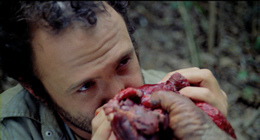
When four arrogant American filmmakers disappear without a trace in the Amazon jungle, an expedition/rescue
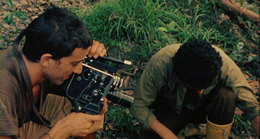 team led by Professor Monroe (Kerman) follows their bloody footsteps to find the lost documentarians. After some tasteless animal atrocities and several false leads, the team stumbles upon "The Tree People," a tribe given to such charming practices as raping and killing a woman with a stone dildo as punishment for adultery. Thanks to a gesture of trust involving skinny dipping, the team is provided with the canisters of film shot by the missing crew, and we switch back to New York City where the footage is screened for appalled financiers. Finally everyone can see firsthand what really happened to cocky director Alan Yates (Yorke) and his three callous friends, who encountered a horror far beyond what anyone could have imagined.
team led by Professor Monroe (Kerman) follows their bloody footsteps to find the lost documentarians. After some tasteless animal atrocities and several false leads, the team stumbles upon "The Tree People," a tribe given to such charming practices as raping and killing a woman with a stone dildo as punishment for adultery. Thanks to a gesture of trust involving skinny dipping, the team is provided with the canisters of film shot by the missing crew, and we switch back to New York City where the footage is screened for appalled financiers. Finally everyone can see firsthand what really happened to cocky director Alan Yates (Yorke) and his three callous friends, who encountered a horror far beyond what anyone could have imagined. 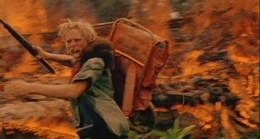 lost in the middle of the wilderness, surrounded by forces whose only intent is to track you down and kill you. The last fifteen minutes, made even more wrenching by Riz Ortolani's rhapsodic music score, have yet to be topped for sheer gut-punch nihilism.
lost in the middle of the wilderness, surrounded by forces whose only intent is to track you down and kill you. The last fifteen minutes, made even more wrenching by Riz Ortolani's rhapsodic music score, have yet to be topped for sheer gut-punch nihilism. 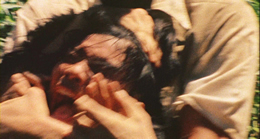
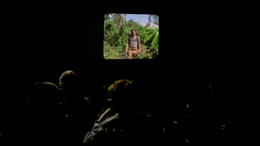 it’s flagged as interlaced; be sure to adjust your player off of progressive playback to avoid blurry motion problems if you see ’em. Deodato and Kerman appear for a full-length audio commentary as well as a selected video commentary; it’s hardly in the same combative territory as the hilarious dueling commentaries from Cannibal Ferox, but Deodato exhibits some of the same defensive techniques used by Lenzi to justify all the critter-killing. Meanwhile Kerman comes off as a jovial and well-grounded guy who was happy to do his job, the second for Deodato after the wonderfully absurd Concorde Affair. The first disc also contains the familiar international trailer, the Italian version with different text cards, Grindhouse’s slightly adapted reissue trailer, the German trailer, and the super-rare original American trailer for the film’s X-rated theatrical play dates. Also
it’s flagged as interlaced; be sure to adjust your player off of progressive playback to avoid blurry motion problems if you see ’em. Deodato and Kerman appear for a full-length audio commentary as well as a selected video commentary; it’s hardly in the same combative territory as the hilarious dueling commentaries from Cannibal Ferox, but Deodato exhibits some of the same defensive techniques used by Lenzi to justify all the critter-killing. Meanwhile Kerman comes off as a jovial and well-grounded guy who was happy to do his job, the second for Deodato after the wonderfully absurd Concorde Affair. The first disc also contains the familiar international trailer, the Italian version with different text cards, Grindhouse’s slightly adapted reissue trailer, the German trailer, and the super-rare original American trailer for the film’s X-rated theatrical play dates. Also 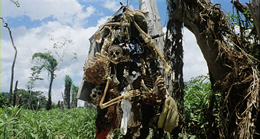 included is the alternate, slightly longer version of the “Road to Hell” sequence found on earlier versions, plus the shooting script accessible via DVD-Rom. Both discs are designed as decrepit film canisters, a nice designing touch, housed in a flip-open case within another cardboard sleeve. Very nice. The insert booklet contains “In the Belly of the Beast,” a lengthy essay by Chas Balun in his typically effusive style.
included is the alternate, slightly longer version of the “Road to Hell” sequence found on earlier versions, plus the shooting script accessible via DVD-Rom. Both discs are designed as decrepit film canisters, a nice designing touch, housed in a flip-open case within another cardboard sleeve. Very nice. The insert booklet contains “In the Belly of the Beast,” a lengthy essay by Chas Balun in his typically effusive style. 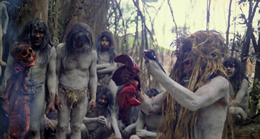 Deodato
Deodato 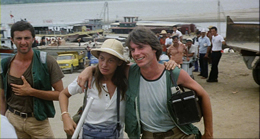 ditching all of the animal death footage entirely, which more than a few viewers would probably appreciate. Deodato and Yorke appear for a handful of exclusive featurettes, "Film and Be Damned" and "The Long Road Back from Hell," covering most of the familiar stories about the production with some additional input in the latter from Ciardi, Kim Newman, and film professors.
ditching all of the animal death footage entirely, which more than a few viewers would probably appreciate. Deodato and Yorke appear for a handful of exclusive featurettes, "Film and Be Damned" and "The Long Road Back from Hell," covering most of the familiar stories about the production with some additional input in the latter from Ciardi, Kim Newman, and film professors. 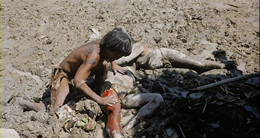 sticking with to get his take on the experience about Italian filmmaking of the era. Perhaps the best moment comes near the end when he gives a detailed account of the agreement the four "documentary" actors made to stay out of the public eye for a year after the film's release to enhance its realism, a tactic adopted less extremely years later by The Blair Witch Project. The 12-minute "Blood on the Camera Lens" features cameraman Roberto Forge Davazati, who also has a
sticking with to get his take on the experience about Italian filmmaking of the era. Perhaps the best moment comes near the end when he gives a detailed account of the agreement the four "documentary" actors made to stay out of the public eye for a year after the film's release to enhance its realism, a tactic adopted less extremely years later by The Blair Witch Project. The 12-minute "Blood on the Camera Lens" features cameraman Roberto Forge Davazati, who also has a 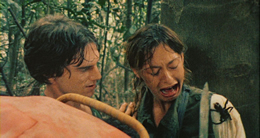 conflicted attitude about the film ("Sometimes I closed one eye while filming") as he chronicles the difficulties of reaching the locations, the different film formats, and the simplicity of some of the special effects. Next comes Deodato's 28-minute Cinema Wasteland panel in 2011 (presumably the same time his other interview here was shot) in which he's flanked by some familiar faces including Ciardi, David Hess, Art Ettinger, and Michael Berryman, while Ciardi goes solo for a surprisingly hilarious 2010 Glasgow convention appearance (11 minutes) with moderator Calum Waddell. A Yorke and Deodato reunion from 2009 at the Fangoria convention in Los Angeles is also a great little 10-minute bit, as they take time to catch up while signing posters for fans, while the previously hidden Deodato and Kerman reunion from 2000 in Tarrytown is included as well..
conflicted attitude about the film ("Sometimes I closed one eye while filming") as he chronicles the difficulties of reaching the locations, the different film formats, and the simplicity of some of the special effects. Next comes Deodato's 28-minute Cinema Wasteland panel in 2011 (presumably the same time his other interview here was shot) in which he's flanked by some familiar faces including Ciardi, David Hess, Art Ettinger, and Michael Berryman, while Ciardi goes solo for a surprisingly hilarious 2010 Glasgow convention appearance (11 minutes) with moderator Calum Waddell. A Yorke and Deodato reunion from 2009 at the Fangoria convention in Los Angeles is also a great little 10-minute bit, as they take time to catch up while signing posters for fans, while the previously hidden Deodato and Kerman reunion from 2000 in Tarrytown is included as well.. Updated review on July 5, 2014.
![]()